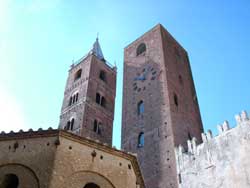Holidays in Albenga
Albium Ingaunum was founded between the 6th and 4th centuries BC. C. by the Romans, who made it an important municipality. Destroyed by the barbarians, it was rebuilt in the 5th century by the future emperor Constantius, then a general. From the 11th century it became a bishopric and capital of the Marca Arduinica . In the year 1000 it participated in the first crusade as a free municipality and finally, in 1251, it passed under Genoa . The walls and many buildings in the historic center were built in the Middle Ages but, due to the filling up of the port, its naval power declined.
To see in Albenga
The former Church of Santa Maria in Fontibus and the thirteenth-century Torre Cazzulini are located in via D'Aste. Along via Ricci the medieval Fieschi - Ricci house and the fourteenth century D'Aste Rolandi - Ricci tower house . On the Roman cardus , the Lengueglia Doria tower house of the XIII - XIV century and the Cepolla Pendant . In via Cavour, the 17th century Palazzo d'Aste. In Piazza San Michele there is the Roman Naval Museum housed in Palazzo Peloso Cepolla ; then there is the Town Hall , with the Tower-House and the Palazzo Vecchio del Comune , which houses the Civic Ingauno Museum . The Cathedral of San Michele , remodeled several times over the centuries, has a facade from the 11th-13th century and the bell tower from 1395. The interiors retain various styles, from the Carolingian crypt to the 13th century floor, but also a 13th century painting and an organ from '700.
 The only late Roman building in the city is the Baptistery , with granite columns, niches and sandstone barriers typical of the Lombard style. Inside, you can admire the only Byzantine mosaic present in Northern Italy outside Ravenna.
The only late Roman building in the city is the Baptistery , with granite columns, niches and sandstone barriers typical of the Lombard style. Inside, you can admire the only Byzantine mosaic present in Northern Italy outside Ravenna.
In Piazza dei Leoni are the sixteenth-century Palazzo Costa del Carretto di Balestrino and the three stone lions from which the square takes its name. In via Episcopio, the Diocesan Museum of Sacred Art inside the Bishop's Palace, with its frescoes, and the Martino di Santa Caterina by Guido Reni. The Pontelungo , buried on the ancient bed of the Centa River , is located along the avenue of the same name and is a great 13th-century work.
One mile from the coast between Alassio and Albenga there is the Gallinara Island , a nature reserve whose coasts can be visited, which was once a shelter for San Martino di Tours and from the eighth century was the seat of an important Benedictine monastery.